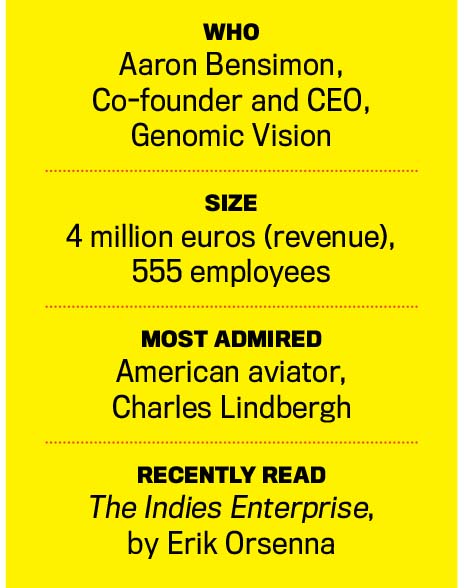 Judging by Dr. Aaron Bensimon’s experience, the road from researcher to CEO of a biotech company is a long and meandering one—but then the CEO of Genomic Vision didn’t exactly set out to found a company. A doctor of molecular biology, he was well into a science career at Paris’s Pasteur Institute when he and his brother began experimenting with stretching single DNA molecules in 1994.
Judging by Dr. Aaron Bensimon’s experience, the road from researcher to CEO of a biotech company is a long and meandering one—but then the CEO of Genomic Vision didn’t exactly set out to found a company. A doctor of molecular biology, he was well into a science career at Paris’s Pasteur Institute when he and his brother began experimenting with stretching single DNA molecules in 1994.
“To do that we had to bind the molecules by one extremity to a solid support—to anchor them,” he recounts. “We succeeded, but it was difficult to bind a single bead. One day, I saw themeniscus, the interface between the air and the water, stretch the DNA—a phenomena we call DNA combing.”
Put simply, the combing process essentially arranges DNA strands in a uniform way—Bensimon describes them as “bar codes.” By using a fluorescent substance to “tag” the strands, the researchers were able to isolate specific genes and more easily hunt for aberrations in the DNA that would be indicative of genetic mutuations.
“I realized pretty quickly that the discovery would help the identification of genetic diseases,” explains Bensimon. Deciding to make the jump from researcher to entrepreneur, he negotiated with Pasteur Institute to gain an exclusive license on his patent portfolio and launched Genomic Vision in 1995. Since the Human Genome Project—the blueprinting of the human genome—would not be completed until 2003, Bensimon faced an uphill battle in getting the world to understand his invention’s potential.
“I would present DNA combing process to the scientific community and people would say, ‘It’s cute,’” he recounts. “I would say, ‘No, it’s not cute. It’s a revolution in terms of what you can do with it.’ I began to understand that while inventors may understand what they can do with their invention, the environment doesn’t always see it. It’s very frustrating to make an avant-garde discovery—one that’s ahead of science in the current environment.”
A turning point came when a French professor who had read about DNA combing contacted Bensimon to explore the idea of using his discovery to aid in the diagnosis of facioscapulohumeral
muscular dystrophy (FSHD). In time, that conversation led to the 2013 launch of Genomic Vision’s first commercialized test—which, in turn, led to a pivotal alliance with Quest Diagnostics to
provide the FSHD test in the U.S., India and Mexico and to partner with Genomic Vision on its research. That accomplishment, however, is just the beginning of Genomic Vision’s potential, says Bensimon.
“FSHD is a rare disease, so it’s not the test that will bring major income,” he explains. “Our blockbusters will be tests for breast cancer, cervical cancer and colon cancer.” Genomic Vision’s strategic plan calls for revenues from these tests to be $500 million, $100 million and $300 million, respectively, in the U.S. alone.
While transitioning from the research world into entrepreneurship put Bensimon on a demanding learning curve, it’s one he has navigated admirably, managing to attract investors and then raise an additional 23 million euros by taking the company public in April of 2014. “I read a lot of books,” he recalls. “I also took an MBA-like course designed for entrepreneurs in France. So I had some tools, but what you really need is perseverance and some of a kind of internal drive where you just won’t give up on what you believe in.”
 The company’s market cap is now a hefty 62 million euros, but Bensimon sees plenty of room for growth. “Our goal is to push the company to become a leader in genetic testing,” he says, noting that the market for molecular diagnostics testing—or the broad arena in which Genomic Vision plays—is projected to grow from $5 billion to $25 billion within a decade. “We want to create partnerships with other companies in addition to Quest Diagnostics and to bring the company to a certain level of independence so that we can develop and spread our technology worldwide.”
The company’s market cap is now a hefty 62 million euros, but Bensimon sees plenty of room for growth. “Our goal is to push the company to become a leader in genetic testing,” he says, noting that the market for molecular diagnostics testing—or the broad arena in which Genomic Vision plays—is projected to grow from $5 billion to $25 billion within a decade. “We want to create partnerships with other companies in addition to Quest Diagnostics and to bring the company to a certain level of independence so that we can develop and spread our technology worldwide.”

Chief Executive Group exists to improve the performance of U.S. CEOs, senior executives and public-company directors, helping you grow your companies, build your communities and strengthen society. Learn more at chiefexecutivegroup.com.
0

1:00 - 5:00 pm
Over 70% of Executives Surveyed Agree: Many Strategic Planning Efforts Lack Systematic Approach Tips for Enhancing Your Strategic Planning Process
Executives expressed frustration with their current strategic planning process. Issues include:
Steve Rutan and Denise Harrison have put together an afternoon workshop that will provide the tools you need to address these concerns. They have worked with hundreds of executives to develop a systematic approach that will enable your team to make better decisions during strategic planning. Steve and Denise will walk you through exercises for prioritizing your lists and steps that will reset and reinvigorate your process. This will be a hands-on workshop that will enable you to think about your business as you use the tools that are being presented. If you are ready for a Strategic Planning tune-up, select this workshop in your registration form. The additional fee of $695 will be added to your total.

2:00 - 5:00 pm
Female leaders face the same issues all leaders do, but they often face additional challenges too. In this peer session, we will facilitate a discussion of best practices and how to overcome common barriers to help women leaders be more effective within and outside their organizations.
Limited space available.

10:30 - 5:00 pm
General’s Retreat at Hermitage Golf Course
Sponsored by UBS
General’s Retreat, built in 1986 with architect Gary Roger Baird, has been voted the “Best Golf Course in Nashville” and is a “must play” when visiting the Nashville, Tennessee area. With the beautiful setting along the Cumberland River, golfers of all capabilities will thoroughly enjoy the golf, scenery and hospitality.
The golf outing fee includes transportation to and from the hotel, greens/cart fees, use of practice facilities, and boxed lunch. The bus will leave the hotel at 10:30 am for a noon shotgun start and return to the hotel after the cocktail reception following the completion of the round.